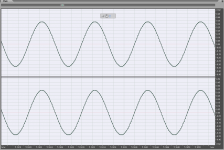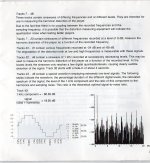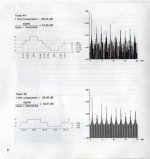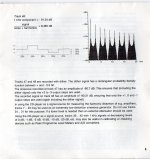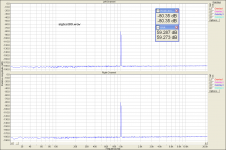Threshod tests 1+2
Just one more, VERY elementary comment.
It does not make much sense to post a test with approx. -100dB signal level, though changing in amplitude, as a 16 bit file. In fact, it is a flaw. For 16 bit signals nothing below -90dB should be tested. To perform amplitude sweep around -100dB, 24-bit signal must be generated. So, this last test should not be taken into account.
Remember maximum for 16-bits is 6.02N +1.76dB = 98.08 dB
Everything below is noise shaping.
Just one more, VERY elementary comment.
It does not make much sense to post a test with approx. -100dB signal level, though changing in amplitude, as a 16 bit file. In fact, it is a flaw. For 16 bit signals nothing below -90dB should be tested. To perform amplitude sweep around -100dB, 24-bit signal must be generated. So, this last test should not be taken into account.
Remember maximum for 16-bits is 6.02N +1.76dB = 98.08 dB
Everything below is noise shaping.
Last edited:
You could mail this guy.What is the frequency distance of individual haircells? Can it be quantified? Is it same over whole band? I am really interested in this, no kidding.
James D. (jj) Johnston Home Page
He has a webblog here with simplyfied info:
Audioskeptic's blog
We can hear sounds below the noise level, so you could try.Just one more, VERY elementary comment.
It does not make much sense to post a test with approx. -100dB signal level, though changing in amplitude, as a 16 bit file. In fact, it is a flaw. For 16 bit signals nothing below -90dB should be tested. To perform amplitude sweep around -100dB, 24-bit signal must be generated. So, this last test should not be taken into account.
Remember maximum for 16-bits is 6.02N +1.76dB = 98.08 dB
Everything below is noise shaping.
But it would be better if you use higher level signals. For instance white noise at -6dBfs with a sine at -20dBfs. Or is this not what you want to test?
Yes we can try, but the signals are extremely unclean then.
Not me, Mooly was testing with amplitude sweep at very very low levels. My suggestion is it would need 24bits rather than 16bits (to detect a threshold of system transparency and audibility).
But it would be better if you use higher level signals. For instance white noise at -6dBfs with a sine at -20dBfs. Or is this not what you want to test?
Not me, Mooly was testing with amplitude sweep at very very low levels. My suggestion is it would need 24bits rather than 16bits (to detect a threshold of system transparency and audibility).
Last edited:
It would be interesting to try different kinds of dither and see what happens.Yes we can try, but the signals are extremely unclean then.
So mine is seriously seriously E+6 bad then
Mr Mooly,
very likely, both your initial files gave me an instant headache. Managed to listen to the 1st file for 30s, 2nd one for 40 seconds before having to give up, 2 paracetamol tablets took care of it within an hour. ''audio-pile'' SC/10W class A amps/K1000.
The track on the full album at youtube sounds ever so boring, but without elements of torture, same setup. Which is interesting.
Back in the '70s/'80s I often listened to tape through Uher reporter/Nak 1000 on a headset, never had a similar experience.
That I'm starting to sound as Frank is the worst part.
(should teach me not to participate in such endeavours, or at least not through headphones)
It would be interesting to try different kinds of dither and see what happens.
But 16 bit = 16 bit. These low levels are only toggling with least significant bit. No "true" signal.
-100dB/24bit is still a soundwave more or less defined.
Attachments
Last edited:
Just one more, VERY elementary comment.
It does not make much sense to post a test with approx. -100dB signal level, though changing in amplitude, as a 16 bit file. In fact, it is a flaw. For 16 bit signals nothing below -90dB should be tested. To perform amplitude sweep around -100dB, 24-bit signal must be generated. So, this last test should not be taken into account.
Remember maximum for 16-bits is 6.02N +1.76dB = 98.08 dB
Everything below is noise shaping.
I tried empirically seeing how low I needed to go in Audacity to produce files that played on my system via speaker, and the same on both my laptops and headphones. Files that began as inaudible, and as amplitude rose, the signals audibly emerged form the noise. I found that any higher in level and the signal was too audible right from the beginning. To me, those two signals emerge as audibly clean as they rise from the noise at around the 17 to 20 second mark.
I tested with Pavel's "sigtestxxx.wav" files.
The system I use for critical listening is good enough to resolve all three, though to hear the -110dBFS tone I have to crank the volume up full and put my ear directly against the speaker. If I tried playing ordinary music at this volume I would doubtless get a flaming woofer cone impacted in the ear. 😱
The system I use for critical listening is good enough to resolve all three, though to hear the -110dBFS tone I have to crank the volume up full and put my ear directly against the speaker. If I tried playing ordinary music at this volume I would doubtless get a flaming woofer cone impacted in the ear. 😱
Last edited:
Mr Mooly,
very likely, both your initial files gave me an instant headache. Managed to listen to the 1st file for 30s, 2nd one for 40 seconds before having to give up, 2 paracetamol tablets took care of it within an hour. ''audio-pile'' SC/10W class A amps/K1000.
The track on the full album at youtube sounds ever so boring, but without elements of torture, same setup. Which is interesting.
Back in the '70s/'80s I often listened to tape through Uher reporter/Nak 1000 on a headset, never had a similar experience.
That I'm starting to sound as Frank is the worst part.
(should teach me not to participate in such endeavours, or at least not through headphones)
Evening Mr Jacco 😉 At least its given you a break from the blowtorch thread 😀
So ultimately, you too could not discern clearly the test tones. Hmmm...
These are (perhaps, because I don't know for sure... but this is what we are trying to find out) all little pieces to the puzzle of what we hear/don't hear. You see, in the same way that I think Pavel finds it strange that we don't all latch on to the cleanest or best or original file, whatever you want to call it, I find it strange that you don't all hear the tones clearly.
There is one common factor. I produced the tones and I backed that up experimentally to see what it would sound like for real, not just on one system with speakers but also on two laptops. The tones are clearly audible.
Pavel produced his own files such as the Bach/Bach1 test and knew exactly what was happening and what the effect of that is sonically and as such has no trouble in identifying the "differences".
Do you see 🙂
I can pick those tones out at twenty paces. They are obvious. But is it because I know exactly what to listen for and winkle them out of the noise so early on in the file.
Just a thought.
The tones in your 'Threshold' files are audible Karl, but all that accompanying digital noise is horrible 😀. There is nothing worse than digital, well defined noise, signal correlated 😀😀
I tested with Pavel's "sigtestxxx.wav" files.
The system I use for critical listening is good enough to resolve all three, though to hear the -110dBFS tone I have to crank the volume up full and put my ear directly against the speaker. If I tried playing ordinary music at this volume I would doubtless get a flaming woofer cone impacted in the ear. 😱
Absolutely. Or you would get instantly deaf when using headphones 😀
That -80dB signal is not too bad, I hope.
Attachments
Last edited:
Richard, I think I've found the signature of sigma-delta DAC bad behaviour, in audible form. abraxalito has a, negative, 'thing' about S-D converters, and I know that I need to follow certain procedures to get the best out of them. But this is the first time I found a signal track which made the behaviour so audibly obvious ...Frank, have you got Audacity/Edit/Preferences/Quality set to Dither None?
This would give the artifacts you describe on low level sine.
Also if Windoz is doing its yucky Sample Rate Conversion.
Foobar2000 uses ASIO and bypasses Windoz.
You're not using Vista by any chance? I don't think there is ANY serious music software that works correctly with Vista.😡
I'm using XP, but so far that hasn't appeared to be a factor - no, this is a hardware issue, which interacts with the way software is driving the hardware. What makes it difficult to 'pin down' is that it's highly inconsistent - the behaviour is also time dependent, definitely not static in nature. As an example, using the exact same driving software and track, the artifacts are different, depending on the history of playback up to that point.
Yesterday, I switched to foobar at one stage, and this was the worst of all! Artifacts were burbling away ferociously - but I don't blame the software, this was most likely a result of the history of playback to that point ...
Fas42, have you tested the digital side of your signal path to make sure it's bit perfect? If you hear artifacts that depend on what player software you're using, that sounds like some sort of software problem.
I need to look at everything - which has been my technique for many years now, nothing new there! ... 😉
The key factor is that the behaviour is time dependent - something I'm very familiar with digital audio, the history of playback from switch on changes things. Of course, there could be some peculiar behaviour where one piece of software changes a setting somewhere, which alters how it behaves next time using the same player from earlier - however, my gut feeling is that this is not the case.
I'll need to run through a few cycles of trying things, to get a better handle on the parameters bearing on the situation ...
BTW, the latest copy of Audacity uses the same resampling engine as SoX - this should help with those noise shaping issues mentioned.
The key factor is that the behaviour is time dependent - something I'm very familiar with digital audio, the history of playback from switch on changes things. Of course, there could be some peculiar behaviour where one piece of software changes a setting somewhere, which alters how it behaves next time using the same player from earlier - however, my gut feeling is that this is not the case.
I'll need to run through a few cycles of trying things, to get a better handle on the parameters bearing on the situation ...
BTW, the latest copy of Audacity uses the same resampling engine as SoX - this should help with those noise shaping issues mentioned.
What is the frequency distance of individual haircells? Can it be quantified? Is it same over whole band? I am really interested in this, no kidding.
Rocking an outer hair cell
This is 3 pieces of info. 3 numbers define the signal EXACTLYA sine does have information: Amplitude, phase and frequency.
To define a noise signal, you can specify spectrum & amplitude (including distribution). But to define/replicate this EXACTLY, you need a zillion numbers.Noise has no information.
Or can we put information in the spectrum and amplitude of the noise?
That's why noise is the most difficult type of signal to compress.
My apologies to da pedants for paraphrasing Nyquist, Shannon bla bla.
________________
You can take a signal below the properly dithered rms noise level of a 16b channel (which BTW is 93.32dB below a FS sine wave. Look up Lipsh*tz & Vanderkooy's various papers on Dither)
I did this in the early 80's when CD and the first digital recorders came out. The Sony PCM F1 could demonstrate both good & bad Digital modes.
You can record piano at -20dB below the 16b noise level; ie at -113dBFS and you can still hear an undistorted but noisy piano on a good 16b recording channel. The same with 1kHz sine.
A bad digital channel with insufficient dither will show crackly quantisation distortion well before you reach -90dBFS and the signal will disappear soon after you hit -93.3dBFS.
The PCM-F1 was what persuaded me that digital record/play works cos it was the best & cleanest recorder I'd used up to that time.
There was at least one test CD with properly dithered tones recorded at low level for testing CD playback. The oversampled Philips players were the best of the early CD players on this simple test ... and more importantly .. on music.
The tones in your 'Threshold' files are audible Karl, but all that accompanying digital noise is horrible 😀. There is nothing worse than digital, well defined noise, signal correlated 😀😀
If it's correlated with the signal, wouldn't it be distortion rather than noise?
My PC uses Realtek HD Audio, which appears to replace KMixer - better? Volumes on max. as per advice around the place, looked around everywhere on the m/c, as I did some time ago, and all looks OK - no funny stuff linked in.
But, have lost the good performance with ramped 24 bit, -90dB 1kHz, using Nero! Just babbling most of the time - what's really, really interesting is that the hardware makes a stab of doing the right thing: right at the start of playing, some of the time, a very clear 1kHz tone is heard which ramps as it should - but about once only ... it disintegrates quite rapidly into mush, and stays that way with continued playing.
So, there is a very precise sequence of actions, software running and warmup is required to get continuous, clean ramping of the -90dB 1kHz signal - again, note that a -70dB ramping is very dirty when everything is 'wrong'.
But, have lost the good performance with ramped 24 bit, -90dB 1kHz, using Nero! Just babbling most of the time - what's really, really interesting is that the hardware makes a stab of doing the right thing: right at the start of playing, some of the time, a very clear 1kHz tone is heard which ramps as it should - but about once only ... it disintegrates quite rapidly into mush, and stays that way with continued playing.
So, there is a very precise sequence of actions, software running and warmup is required to get continuous, clean ramping of the -90dB 1kHz signal - again, note that a -70dB ramping is very dirty when everything is 'wrong'.
- Status
- Not open for further replies.
- Home
- General Interest
- Everything Else
- Based on sonics... which do you prefer ?
